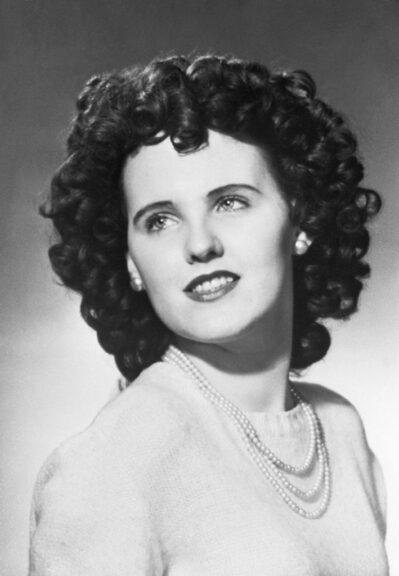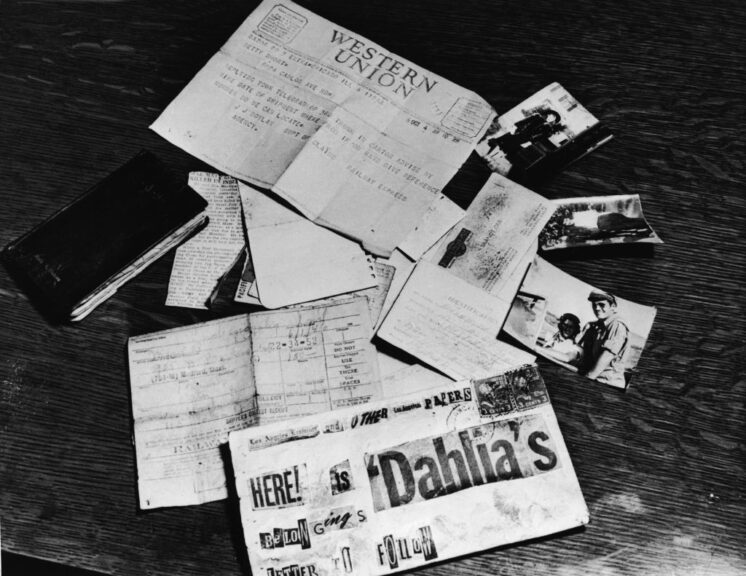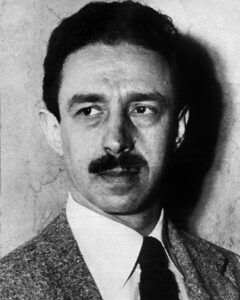On January 15, 1947, a mother was taking her 3-year-old daughter for a walk in the Los Angeles neighborhood of Leimert Park, which at the time was mostly undeveloped.
In one of the vacant lots, just feet from the sidewalk, the mother saw what she initially believed to be a mannequin, according to the FBI. Upon closer inspection, however, it was discovered that it was the body of a woman who had been completely severed at the waist. She had been drained of blood and her skin was a sickly white color.
“I glanced to my right, and saw this very dead, white body,” the woman said in a 1997 interview, according to the Los Angeles Times. “My goodness … it was so white. It didn’t … look like anything more than perhaps an artificial model. It was so white and separated in the middle. I noticed the dark hair and this white, white form.”
Her face was slashed from the corners of her mouth to her ears, with additional cuts on her thigh and breasts that had sliced away part of her flesh. Her lower body was about a foot away from her upper body, with her legs spread and her intestines tucked beneath her buttocks. Her arms were bent at the elbows and positioned above her head. Police found a heel print near the body and a sack containing watery blood not far away.
Fingerprints identified the murdered woman as 22-year-old Elizabeth Short, who had been arrested in 1943 for underage drinking. An autopsy revealed that Elizabeth had ligature marks on her ankles, wrists, and neck, along with superficial cuts on her arms and part of her chest. The technique used to cut the body in half, known as a hemicorporectomy, suggested her killer had medical training.
Her official cause of death was hemorrhaging from the cuts on her face and shock from her head being beaten.
Elizabeth was born in Boston, Massachusetts, on July 29, 1924, the middle child of five sisters. Her father built miniature golf courses until the 1929 stock market crash when he lost most of his savings. A year later, his car was found abandoned at the Charlestown Bridge, suggesting he had jumped into the Charles River to commit suicide.

Head shot of aspiring actress Elizabeth Short, a murder victim nicknamed the Black Dahlia. Getty Images.
Elizabeth had breathing problems as a child, so her mother moved the family to Miami, Florida, following her father’s disappearance. In 1942 – 12 years after he was believed to have committed suicide – Elizabeth’s father wrote her a letter apologizing for running away and telling her he had started a new life in California. Later that same year, Elizabeth moved to Vallejo, California, to live with her father. After moving around in California and briefly back to Florida following her underage drinking arrest, Elizabeth moved to Los Angeles to visit an acquaintance who was in the military. She would spend the last six months of her life in southern California.
While it has been commonly reported that Elizabeth was an aspiring actress, there is no record of her having any acting jobs or credits.
On January 9, 1947 – a week before her body was discovered – Elizabeth had returned to her home in Los Angeles after visiting a married man in San Diego she had been dating. The man had dropped Elizabeth off at the Biltmore Hotel. Some reports indicated that staff at the hotel had seen Elizabeth using the telephone in the lobby, but a 1997 Los Angeles Times article questions the claims, finding no evidence that she was seen at the hotel in “heated news accounts of the day, which reported on every conceivable contact anyone had with Short in the so-called ‘missing week’ before her death.”
The media sensationalized the case, reporting various unverified claims that Elizabeth was a prostitute or pregnant or even a lesbian. Some claimed that the black tailored suit Elizabeth had been last seen wearing was “a tight skirt and a sheer blouse.”
The Los Angeles Examiner, whose reporter beat police to the scene and later said he was the one to close Elizabeth’s eyes, went so far as to trick Elizabeth’s mother by saying Elizabeth had won a beauty contest. The ruse was to get information about Elizabeth for their story, and only after they received all they could, revealed that Elizabeth had been found murdered. The paper also paid for Elizabeth’s mother to fly to L.A. to help police with the investigation, but when she arrived, the paper kept the woman from the police and reporters.
Elizabeth was dubbed the “Black Dahlia,” with reporters claiming credit for the name. It reportedly came from her alleged penchant for wearing sheer black clothes and the 1946 movie “The Blue Dahlia.” It is also rumored to have been a nickname she received while frequenting a Long Beach drugstore.
Six days after Elizabeth’s body was found, the editor of the L.A. Examiner received a call from a man claiming to be her killer. The man said he planned on turning himself in but wanted the police to chase him a bit longer. He also told the editor that he would be sending some “souvenirs” of Elizabeth’s soon. Three days later, on January 24, a manila envelope addressed to the Examiner and other papers were discovered, with words comprising letters cut out of newspaper articles. Inside the envelope were Elizabeth’s birth certificate, business cards, photographs, pieces of paper with various names written on it, and an address book that belonged to a man named Mark Hansen.

Evidence concerning the murder of American aspiring actress and murder victim Elizabeth Short (1924 – 1947), known as the ‘Black Dahlia.’ (Photo by INTERNATIONAL NEWS PHOTO/Getty Images)
No fingerprints were lifted from the envelope or items, since it had been cleaned with gasoline. Elizabeth’s body had been cleaned in the same way, leading police to believe the items had been sent by her killer. On the same day the envelope arrived, a black handbag and shoe were found two miles from the crime scene, both of which had also been cleaned with gasoline.
On January 26, another letter arrived, with a handwritten note saying the alleged killer would turn himself in on a specific date and time. Police waited, but no one appeared. On the day the man was supposed to turn himself in, the Examiner received another letter, purportedly from the killer, saying he changed his mind and that his killing of Elizabeth was “justified,” but offered no additional details.

Robert “Red” Manley identifies Elizabeth Short’s purse in the Black Dahlia murder case. Getty Images.
Police looked into Mark Hansen, whose address book was sent to the Examiner along with Elizabeth’s identification. Hansen owned a nightclub and theater and Elizabeth had briefly stayed with him at one point along with her friends. Hansen was cleared of suspicion, however, along with many other men were potential suspects.
The man with whom Elizabeth was having an affair prior to her death was also cleared, as was an acquaintance who was listed in Hansen’s address book. Another man, a bellhop who was an associate of Hansen, was long believed by some to be responsible for Elizabeth’s murder. The bellhop was actually in San Francisco when Elizabeth had been killed.
Two months after the envelope with items belonging to Elizabeth was received, on March 14, a pile of men’s clothing was found in Venice, California. Inside a shoe, a note was found that said: “To whom it may concern: I have waited for the police to capture me for the Black Dahlia killing, but have not. I am too much of a coward to turn myself in, so this is the best way out for me. I couldn’t help myself for that, or this. Sorry, Mary.”
The clothing did not provide any evidence pointing to an owner or the writer of the alleged suicide note.
Numerous other people have confessed or claimed a family member was Elizabeth’s killer, but those claims were dismissed by police as false. Some people were even charged with obstruction of justice.
George Hodel, who was never charged with Elizabeth’s murder, remains one of the most longstanding suspects. In 2003, the Los Angeles Times reported on notes from the 1949 grand jury report on how the LAPD handled various murders, including Elizabeth’s. The notes revealed that investigators had wiretapped Hodel’s home and recorded a conversation between him and another person in which he said: “Supposin’ I did kill the Black Dahlia. They couldn’t prove it now. They can’t talk to my secretary because she’s dead. They thought there was something fishy. Anyway, now they may have figured it out. Killed her. Maybe I did kill my secretary.”

Dr. George Hill Hodel. 38, party involved in alleged incest case and Black Dahlia story. (Photo By: NY Daily News via Getty Images)
Hodel had also been suspected of killing his secretary Ruth Spaulding, but he was never charged. Hodel’s son, LAPD homicide detective Steve Hodel, also accused his father of being Elizabeth’s murderer, after George died in 1999. Steve wrote a book about his theory, which was dismissed by the LAPD detective in charge of Elizabeth’s case in the ’90s. The detective said the books included some intriguing facts but only linked to Elizabeth through unsubstantiated theories.
Steve has also tried to link his father to the Zodiac killings and other unsolved cases.
Around 750 investigators worked on the case initially, and many places were searched but no additional evidence was found. The case remains unsolved.

Continue reading this exclusive article and join the conversation, plus watch free videos on DW+
Already a member?

.png)
.png)

